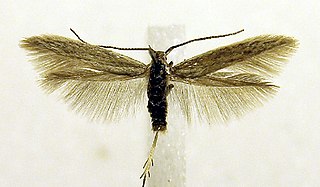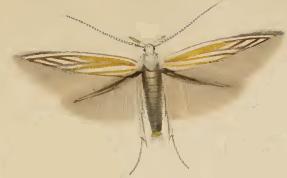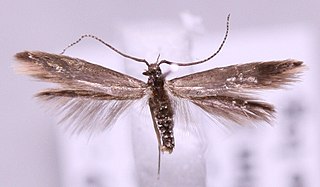
Vaccinium vitis-idaea, the lingonberry, partridgeberry, mountain cranberry or cowberry, is a small evergreen shrub in the heath family Ericaceae, that bears edible fruit. It is native to boreal forest and Arctic tundra throughout the Northern Hemisphere, from Europe and Asia to North America. Lingonberries are picked in the wild and used to accompany various dishes, primarily in the Nordic countries. Commercial cultivation is undertaken in the U.S. Pacific Northwest and in the Netherlands.

Coleophora vitisella is a moth of the family Coleophoridae. It is found from Fennoscandia and northern Russia to the Pyrenees and Italy and from Great Britain to Romania. The range extends to the Russian Far East. The species was recently discovered in Canada, with records from Yukon and Manitoba.
Coleophora vacciniella is a moth of the family Coleophoridae. It is found from Fennoscandia and northern Russia to the Pyrenees and Italy and from France to Romania.
Coleophora uliginosella is a moth of the family Coleophoridae. It is found from Fennoscandia and northern Russia to the Pyrenees and Italy and from France to the Baltic states and Poland.

Coleophora solitariella is a moth of the family Coleophoridae. It is found from Fennoscandia to the Pyrenees, Italy and Romania and from Great Britain to southern Russia.

Coleophora siccifolia is a moth of the family Coleophoridae. It is found in most of Europe.

Coleophora serpylletorum is a moth of the family Coleophoridae found in Europe. It was first described by Erich Martin Hering in 1889.

Coleophora atriplicis is a moth of the family Coleophoridae found in Europe and North America.

Coleophora boreella is a moth of the family Coleophoridae. It is found from Fennoscandia and northern Russia to the Netherlands and Poland.

Coleophora caelebipennella is a moth of the family Coleophoridae. It is found in most of Europe, except Great Britain, Ireland and the Balkan Peninsula. It is also known from Pakistan.
Coleophora calycotomella is a moth of the family Coleophoridae. It is found from the Netherlands and Germany to the Iberian Peninsula, Sardinia, Sicily and Crete.

Coleophora cornutella is a moth of the family Coleophoridae. It is found from Fennoscandia to the Pyrenees and the Alps and from France to Romania.

Coleophora currucipennella is a moth of the family Coleophoridae found in Europe. It was first described by Philipp Christoph Zeller in 1839.
Coleophora lassella is a moth of the family Coleophoridae found in Europe.

Coleophora fuscocuprella is a moth of the family Coleophoridae. It is found from Fennoscandia to the Pyrenees, Italy, Albania and Romania and from Ireland to Russia.
Coleophora idaeella is a moth of the family Coleophoridae. It is found from Fennoscandia and northern Russia to the Pyrenees and the Alps and from Great Britain to Poland.
Coleophora onopordiella is a moth of the family Coleophoridae. It is found in France and Italy, and from Poland to Greece.
Coleophora plumbella is a moth of the family Coleophoridae. It is found from Fennoscandia to Romania.

Coleophora squalorella is a moth of the family Coleophoridae. It is found from Fennoscandia to Austria, Croatia, Romania and Ukraine and from the Netherlands to the Baltic states. It is also known from the lower Volga and Ural regions of Russia and China. It occurs in steppe and semi-desert biotopes.

Coleophora sylvaticella is a moth of the family Coleophoridae found in Europe.








